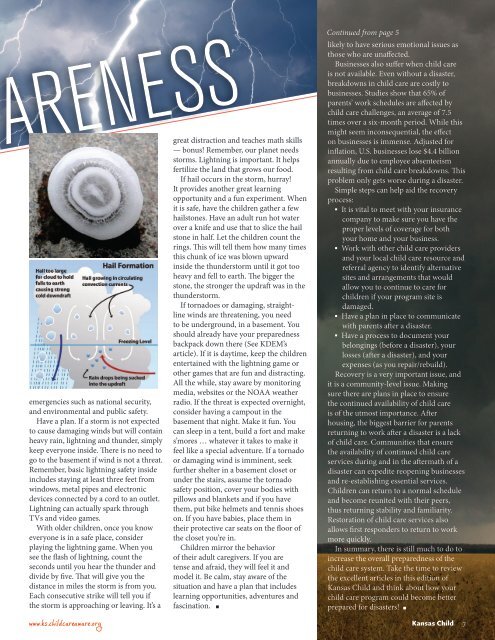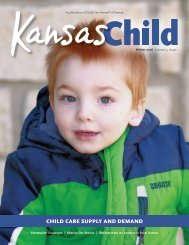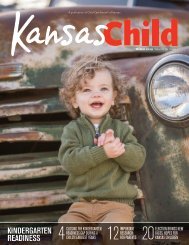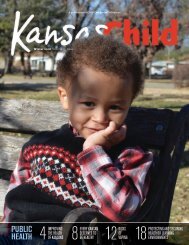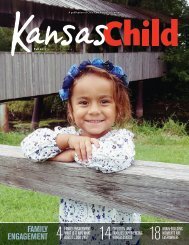2017 Spring Kansas Child
Emergency Preparedness
Emergency Preparedness
You also want an ePaper? Increase the reach of your titles
YUMPU automatically turns print PDFs into web optimized ePapers that Google loves.
ARENESS<br />
emergencies such as national security,<br />
and environmental and public safety.<br />
Have a plan. If a storm is not expected<br />
to cause damaging winds but will contain<br />
heavy rain, lightning and thunder, simply<br />
keep everyone inside. There is no need to<br />
go to the basement if wind is not a threat.<br />
Remember, basic lightning safety inside<br />
includes staying at least three feet from<br />
windows, metal pipes and electronic<br />
devices connected by a cord to an outlet.<br />
Lightning can actually spark through<br />
TVs and video games.<br />
With older children, once you know<br />
everyone is in a safe place, consider<br />
playing the lightning game. When you<br />
see the flash of lightning, count the<br />
seconds until you hear the thunder and<br />
divide by five. That will give you the<br />
distance in miles the storm is from you.<br />
Each consecutive strike will tell you if<br />
the storm is approaching or leaving. It’s a<br />
great distraction and teaches math skills<br />
— bonus! Remember, our planet needs<br />
storms. Lightning is important. It helps<br />
fertilize the land that grows our food.<br />
If hail occurs in the storm, hurray!<br />
It provides another great learning<br />
opportunity and a fun experiment. When<br />
it is safe, have the children gather a few<br />
hailstones. Have an adult run hot water<br />
over a knife and use that to slice the hail<br />
stone in half. Let the children count the<br />
rings. This will tell them how many times<br />
this chunk of ice was blown upward<br />
inside the thunderstorm until it got too<br />
heavy and fell to earth. The bigger the<br />
stone, the stronger the updraft was in the<br />
thunderstorm.<br />
If tornadoes or damaging, straightline<br />
winds are threatening, you need<br />
to be underground, in a basement. You<br />
should already have your preparedness<br />
backpack down there (See KDEM’s<br />
article). If it is daytime, keep the children<br />
entertained with the lightning game or<br />
other games that are fun and distracting.<br />
All the while, stay aware by monitoring<br />
media, websites or the NOAA weather<br />
radio. If the threat is expected overnight,<br />
consider having a campout in the<br />
basement that night. Make it fun. You<br />
can sleep in a tent, build a fort and make<br />
s’mores … whatever it takes to make it<br />
feel like a special adventure. If a tornado<br />
or damaging wind is imminent, seek<br />
further shelter in a basement closet or<br />
under the stairs, assume the tornado<br />
safety position, cover your bodies with<br />
pillows and blankets and if you have<br />
them, put bike helmets and tennis shoes<br />
on. If you have babies, place them in<br />
their protective car seats on the floor of<br />
the closet you’re in.<br />
<strong>Child</strong>ren mirror the behavior<br />
of their adult caregivers. If you are<br />
tense and afraid, they will feel it and<br />
model it. Be calm, stay aware of the<br />
situation and have a plan that includes<br />
learning opportunities, adventures and<br />
fascination. n<br />
Continued from page 5<br />
likely to have serious emotional issues as<br />
those who are unaffected.<br />
Businesses also suffer when child care<br />
is not available. Even without a disaster,<br />
breakdowns in child care are costly to<br />
businesses. Studies show that 65% of<br />
parents’ work schedules are affected by<br />
child care challenges, an average of 7.5<br />
times over a six-month period. While this<br />
might seem inconsequential, the effect<br />
on businesses is immense. Adjusted for<br />
inflation, U.S. businesses lose $4.4 billion<br />
annually due to employee absenteeism<br />
resulting from child care breakdowns. This<br />
problem only gets worse during a disaster.<br />
Simple steps can help aid the recovery<br />
process:<br />
•§<br />
It is vital to meet with your insurance<br />
company to make sure you have the<br />
proper levels of coverage for both<br />
your home and your business.<br />
•§<br />
Work with other child care providers<br />
and your local child care resource and<br />
referral agency to identify alternative<br />
sites and arrangements that would<br />
allow you to continue to care for<br />
children if your program site is<br />
damaged.<br />
•§<br />
Have a plan in place to communicate<br />
with parents after a disaster.<br />
•§<br />
Have a process to document your<br />
belongings (before a disaster), your<br />
losses (after a disaster), and your<br />
expenses (as you repair/rebuild).<br />
Recovery is a very important issue, and<br />
it is a community-level issue. Making<br />
sure there are plans in place to ensure<br />
the continued availability of child care<br />
is of the utmost importance. After<br />
housing, the biggest barrier for parents<br />
returning to work after a disaster is a lack<br />
of child care. Communities that ensure<br />
the availability of continued child care<br />
services during and in the aftermath of a<br />
disaster can expedite reopening businesses<br />
and re-establishing essential services.<br />
<strong>Child</strong>ren can return to a normal schedule<br />
and become reunited with their peers,<br />
thus returning stability and familiarity.<br />
Restoration of child care services also<br />
allows first responders to return to work<br />
more quickly.<br />
In summary, there is still much to do to<br />
increase the overall preparedness of the<br />
child care system. Take the time to review<br />
the excellent articles in this edition of<br />
<strong>Kansas</strong> <strong>Child</strong> and think about how your<br />
child care program could become better<br />
prepared for disasters! n<br />
www.ks.childcareaware.org <strong>Kansas</strong> <strong>Child</strong> 7


